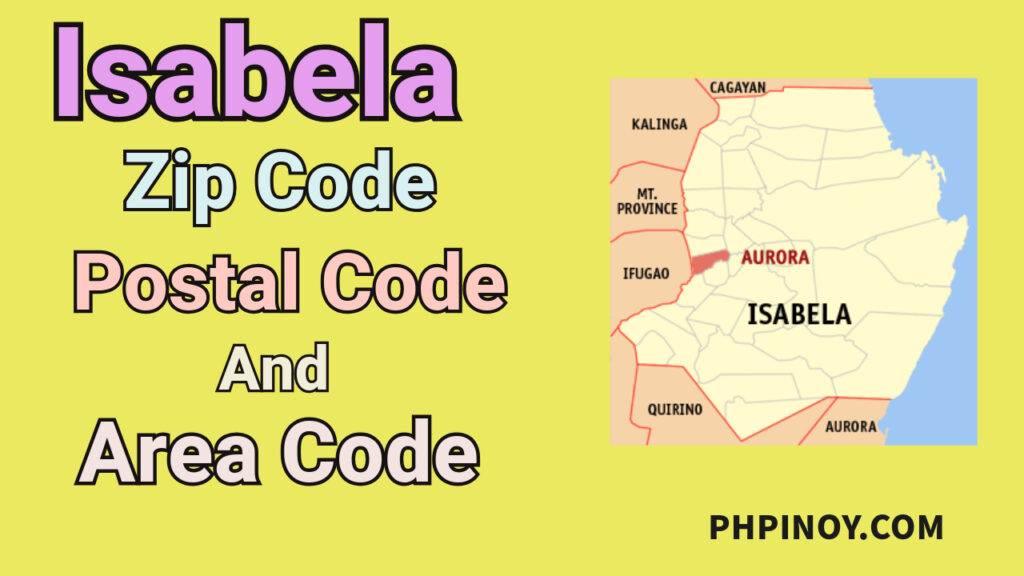Isabela is known as Sentro ng Agrikultura, the Top Corn Producer of the Philippines, Rice Bowl of the North, and Queen Province of the North. Based on land area, this is the second largest province in the country, situated in Region 2. It has a plain and rolling terrain, making rice and corn its top agricultural products. The name of this province comes from the Queen Regnant of Spain, Isabella II. There are a lot of tourist attractions, churches, and festivals that attract tourists.
Isabela ZIP Codes, Postal Codes, and Area Codes
The province of Isabela has one independent city, two component cities, and thirty-four municipalities. Here are the Isabela’s Postal Codes, Zip Codes, and Area Codes.
| City/Municipality | Postal Code / Zip Code | Area Code |
| Alicia | 3306 | 078 |
| Angadanan | 3307 | 078 |
| Aurora | 3316 | 078 |
| Benito Soliven | 3331 | 078 |
| Burgos | 3322 | 078 |
| Cabagan | 3328 | 078 |
| Cabatuan | 3315 | 078 |
| City of Cauayan | 3305 | 078 |
| City of Ilagan | 3300 | 078 |
| Cordon | 3312 | 078 |
| Delfin Albano | 3326 | 078 |
| Dinapigue | 3336 | 078 |
| Divilacan | 3335 | 078 |
| Echague | 3309 | 078 |
| Gamu | 3301 | 078 |
| Jones | 3313 | 078 |
| Luna | 3304 | 078 |
| Maconacon | 3333 | 078 |
| Mallig | 3323 | 078 |
| Naguillan | 3302 | 078 |
| Palanan | 3334 | 078 |
| Quirino | 3321 | 078 |
| Quezon | 3324 | 078 |
| Ramon | 3319 | 078 |
| Reina Mercedes | 3303 | 078 |
| Roxas | 3320 | 078 |
| San Agustin | 3314 | 078 |
| San Guillermo | 3308 | 078 |
| San Isidro | 3310 | 078 |
| San Manuel | 3317 | 078 |
| San Mariano | 3332 | 078 |
| San Mateo | 3318 | 078 |
| San Pablo | 3329 | 078 |
| Santa Maria | 3330 | 078 |
| Santiago City | 3311 | 078 |
| Santo Tomas | 3327 | 078 |
| Tumauini | 3325 | 078 |
Key Areas of Isabela
Here are some of the key areas of Isabela that comprise cities and municipalities, highlighting the province’s cultures, economy, and tourism. These areas offer many activities that make Isabela a must-visit place.
1. Santiago City. One of the fastest-growing local economies in the country. Some places of interest in this city are Balay na Santiago, Calvary Hills and The Chapel of Transfiguration, and Santiago Concrete Water Tank (Philippines’ Tallest Mural). They also have vibrant festivals and events like Balamban Dance Festival and Feast of St. James the Apostle (Santiago de Carig).
2. Cauayan. The name of this place comes from the word “Cawayan,” a term for bamboo in the language of the early settlers in it. Some major destinations and cultural festivities are Our Lady of the Pillars Church, Cortez and Lindon Fruit Farm, Dacuycuy Farms, and Gawagaway-yan Festival.
3. Ilagan. It is known as the Center of Eco-Tourism Adventure in Region 2, the Corn Capital of the Philippines, and Home of the World’s Largest Wooden Lounge Chair, also called “Butaka.” This city has a lot of attractions and distinctive culture that fascinate locals and tourists.
4. Palanan. Palanan is one of Isabela’s hidden gems and best-kept secrets, as it has a lot of tourist attractions that showcase its culture and unique identity. There is also a shrine, an ancient burial site, a lake, falls, beaches, a cave, and other historical landmarks. Some of Palanan’s products are seafood and woven products.
5. Tumauini. The Tumauini Church is one of the notable historical landmarks in this municipality. Another famous place in the area is Camp Samal Resort and Leisure Park, situated at a high altitude, offering a great view and a Tagaytay vibe.
FAQs
What is the Province of Isabela known for?
The Province of Isabela is known for its agricultural products, historical landmarks, and tourist spots.
What is the dialect of Isabela?
Ilocano is the common dialect of Isabela. The other languages in the province are Ibanag, Gaddang, Tagalog, Yogad, and English.
What is the main product of Isabela?
The main products of Isabela are agricultural products, such as corn and rice. The other products are seafood and handicrafts.
What is the culture of Isabela?
Isabela’s unique culture is shown in its festivals and other traditions. The other things that show its culture are its landmarks, ethnolinguistic groups, indigenous groups, and Ilocano language.
